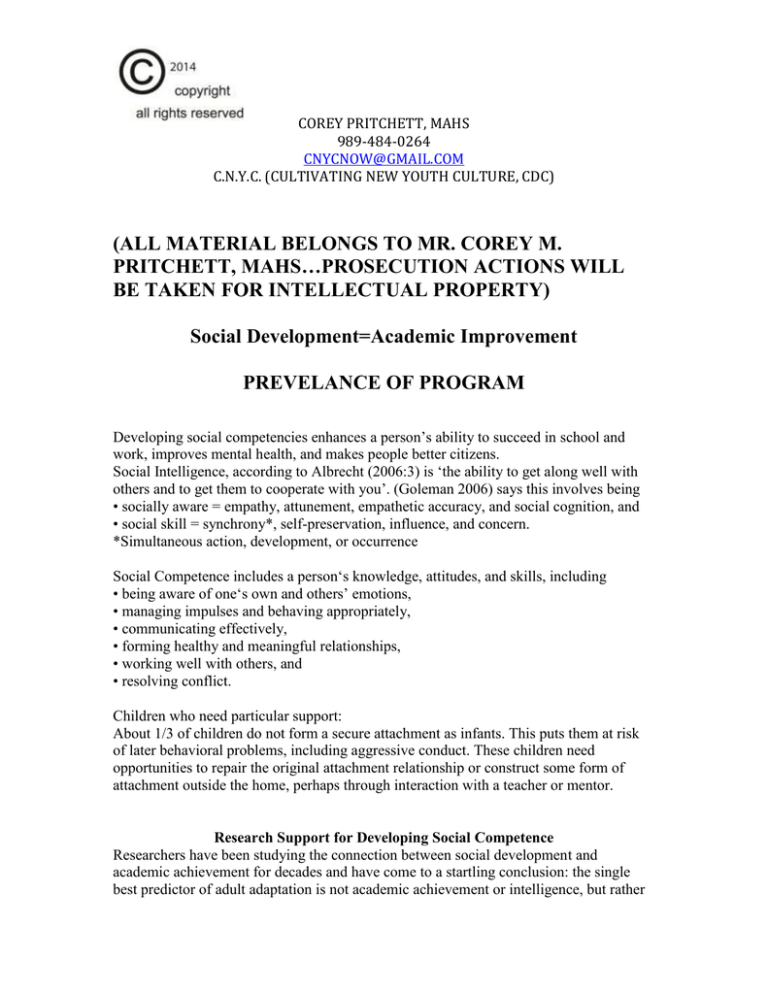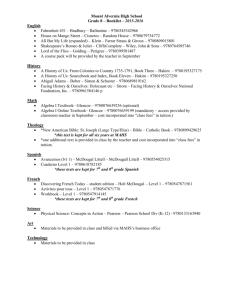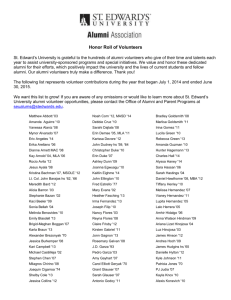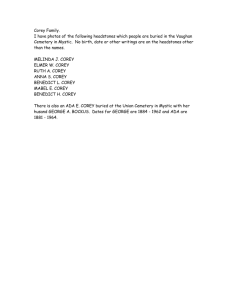File - {YOUTH LIFE COACH} {INSPIRATIONAL SPEAKER}
advertisement

COREY PRITCHETT, MAHS 989-484-0264 CNYCNOW@GMAIL.COM C.N.Y.C. (CULTIVATING NEW YOUTH CULTURE, CDC) (ALL MATERIAL BELONGS TO MR. COREY M. PRITCHETT, MAHS…PROSECUTION ACTIONS WILL BE TAKEN FOR INTELLECTUAL PROPERTY) Social Development=Academic Improvement PREVELANCE OF PROGRAM Developing social competencies enhances a person’s ability to succeed in school and work, improves mental health, and makes people better citizens. Social Intelligence, according to Albrecht (2006:3) is ‘the ability to get along well with others and to get them to cooperate with you’. (Goleman 2006) says this involves being • socially aware = empathy, attunement, empathetic accuracy, and social cognition, and • social skill = synchrony*, self-preservation, influence, and concern. *Simultaneous action, development, or occurrence Social Competence includes a person‘s knowledge, attitudes, and skills, including • being aware of one‘s own and others’ emotions, • managing impulses and behaving appropriately, • communicating effectively, • forming healthy and meaningful relationships, • working well with others, and • resolving conflict. Children who need particular support: About 1/3 of children do not form a secure attachment as infants. This puts them at risk of later behavioral problems, including aggressive conduct. These children need opportunities to repair the original attachment relationship or construct some form of attachment outside the home, perhaps through interaction with a teacher or mentor. Research Support for Developing Social Competence Researchers have been studying the connection between social development and academic achievement for decades and have come to a startling conclusion: the single best predictor of adult adaptation is not academic achievement or intelligence, but rather COREY PRITCHETT, MAHS 989-484-0264 CNYCNOW@GMAIL.COM C.N.Y.C. (CULTIVATING NEW YOUTH CULTURE, CDC) the ability of the child to get along with other children (Hartup, 1992). Additionally, Wentzle (1993) found that prosocial and antisocial behavior are significantly related to grade point average and standardized test scores, as well as teachers’ preferences for the student. These studies, and others like them, indicate that a socially adjusted child is more likely to be the academically successful child. What young children need to learn: According to Erikson, very young children can develop an inability to take action on their own and/or developing a sense of inferiority, unproductiveness, and feelings of incompetence in regards to their peers and their social roles and abilities if not supported adequately to be trusting, autonomous and to take initiative. How to positively influence social development • Build positive relationships with children, families and colleagues • Design supportive and engaging environments • Teach social and emotional awareness and skills References Albrecht, K. (2006). Social intelligence: The new science of success. San Francisco: Jossey-Bass. Goleman, D. (2006). Social intelligence: The revolutionary new science of human relationships. New York, New York: Bantam Dell. Hartup, W. (1992). Having friends, making friends, and keeping friends: Relationships as educational contexts. ERIC Digest. Champaign, IL: ERIC Clearinghouse on Elementary and Early Childhood Education. ED 345 854. Retrieved from http://ceep.crc.illinois.edu/pubs/ivpaguide/appendix/hartup-friends.pdf Huitt, W. & Dawson, C. (2011, April). Social development: Why it is important and how to impact it. Educational Psychology Interactive. Valdosta, GA: Valdosta State University. Wentzel, K. (1993). Does being good make the grade? Social behavior and academic competence in middle school. Journal of Educational Psychology, 85(2), 357-364. COREY PRITCHETT, MAHS 989-484-0264 CNYCNOW@GMAIL.COM C.N.Y.C. (CULTIVATING NEW YOUTH CULTURE, CDC) I. Protective Factors are factors that contribute to resiliency. Below are some protective factors for some mental health challenges(relevant/within the context of this program): Good self-esteem Good problem-solving skills/Conflict resolution Having a good social support system (Maryland Department of Health and Mental Hygeine, Missouri Department of Mental Health, and National Council for Community Behavioral Healthcare. (2012) Youth Mental Health First Aid USA Assisting Young People. Pg. 19) II. Depression has no single cause and often involves the interaction of many diverse biological, psychological, and social factors. Relevant Risk Factors for depression(within context of this program): Social disadvantage Lack of close, confiding relationship with someone Learning and other school difficulties(social environment) (Maryland Department of Health and Mental Hygeine, Missouri Department of Mental Health, and National Council for Community Behavioral Healthcare. (2012) Youth Mental Health First Aid USA Assisting Young People. Pg. 43) III. Eating Disorders- A young person with an eating disorder can experience a wide range of physical and emotional health problems. Serious health consequences associated with eating disorders include severe malnutrition, brain dysfunction, and kidney or heart failiure. Suicide can also be a result. A range of biological, psychological, and social factors may contribute to the development of an eating disorder. Below are some risk-factors of an Eating Disorder relevant to this program: Psychological: Low self-esteem Perfectionism Social: COREY PRITCHETT, MAHS 989-484-0264 CNYCNOW@GMAIL.COM C.N.Y.C. (CULTIVATING NEW YOUTH CULTURE, CDC) Critical comments from others about eating, weight, or body shape Pressure to be slim Adapting to new culture with new ideals of body types Environmental/social stress (Maryland Department of Health and Mental Hygeine, Missouri Department of Mental Health, and National Council for Community Behavioral Healthcare. (2012) Youth Mental Health First Aid USA Assisting Young People. Pp 76-77) IV. Substance use has a potential harmful effects on the developing brain and the young person’s mental health; a strong association with a high-rsik taking behavior; and the potential to develop into a substance-related disorder. Pg 110 Below are some of the Risk Factors related to this program: Drinking may be considered normal in the adolescent’s peer or cultural group Not feeling connected to family, school, or community (relationship building) Social disadvantage (Maryland Department of Health and Mental Hygeine, Missouri Department of Mental Health, and National Council for Community Behavioral Healthcare. (2012) Youth Mental Health First Aid USA Assisting Young People. Pg. 104) Outcome Objective To begin to establish and cultivate what Psychologists call Positive Youth Development or PYD. PYD has especially been promoted by psychologist Jacqueline Lerner and her colleagues (2009), who recently described the 5 C's of PYD that will be imparted unto youth. They are: 1. Competence, which involves having a positive perception of one's actions in domainspecific areas-social, academic, physical, career, and so on. 2. Confidence, which consists of having an overall positive sense of self-worth and selfefficacy( a sense that one can master a situation and produce positive outcomes) 3. Connection, which is characterized by having a positive relationship with others, including family, peers, teachers, and individuals within the community. COREY PRITCHETT, MAHS 989-484-0264 CNYCNOW@GMAIL.COM C.N.Y.C. (CULTIVATING NEW YOUTH CULTURE, CDC) 4. Character, which is comprised of having respect for societal rules, an understanding of right and wrong, and integrity. 5. Caring/Compassion, which encompasses showing emotional concern for others, especially those in distress. "Lerner and her colleagues conclude that in order to develop these five C's that youth need to be exposed and have access to positive social contexts- such as youth development programs and organized youth activities and competent people -such as caring teachers, community leaders and mentors." (Santrock, Adolescence 13th edition pg. 10) Developing positive self-esteem and building positive relationships encompasses every dynamic of PYD. More objectives of the SOCIAL SKILLS BOOTCAMPS are to reduce risks of mental disorders such as bi-polar; reduce risks of having hypertension as an adult; cope with stressful life circumstances; create less tolerant attitudes toward suicide; decrease desires for promiscuous sexual behaviors; decrease drug involvement risks; lessen the risk of delinquency; improve educational attainment; created sense of well-being; and give hope, purpose, and meaning of life. SOCIAL SKILL BOOTCAMPS AVAILABLE (SELF-ESTEEM BOOTCAMP EXAMPLE PROVIDED): 1. SELF ESTEEM- 9 weeks 2. PEER PRESSURE- 6 weeks 3. POSITIVE PEER INTERACTION- 6 weeks 4. RESILIENCY- 6 weeks 5. RELATIONSHIP BUILDING- 6 weeks 6. FRIENDSHIPS- 6 weeks 7. TEENAGE DATING- 8 weeks 8. TEENAGE PARENTHOOD- 6 weeks 9. COMMUNICATION- 9 weeks 10. LEADERSHIP- 8 weeks 11. CULTURE- 9 weeks 12. NEW YOUTH CULTURE- 9 weeks 13. CONFLICT RESOLUTION- 6 weeks 14. DECISION MAKING- 8 weeks 15. CHARACTER- 6 weeks 16. SOCIAL NETWORKS- 6 weeks COREY PRITCHETT, MAHS 989-484-0264 CNYCNOW@GMAIL.COM C.N.Y.C. (CULTIVATING NEW YOUTH CULTURE, CDC) (length of bootcamps are 6-9 weeks, but may be adjusted to fit the desire of those being served) **8-10 STUDENTS PREFRRED PER BOOTCAMP** **BOOTCAMPS ARE 30-45 MINUTES PER SESSION AND HELD ONCE A WEEK PER BOOTCAMP…I.E. SELF-ESTEEM BOOTCAMP WOULD BE ON MONDAYS FROM 11:00AM-11:45AM FOR 9 WEEKS(MONDAYS)*** BUDGET: 9 WEEK BOOTCAMPS TOTAL $3,500.00 6 WEEK BOOTCAMPS TOTAL $2,500.00 8 WEEK BOOTCAMPS TOTAL $3,000.00 SELF-ESTEEM BOOTCAMP Understanding self-esteem is key to developing a positive self and reaching personal goals. Assessment of self/self-esteem is also a determining factor in establishing the perceptions children/adolescents/adults have of themselves as they think others see them. It affects what they think they look like to others. This bootcamp assists individuals with enhancing self-esteem and believing in themselves. Week #1 Self-Esteem – The esteem or good opinion of oneself; vanity. Quality – Sort, kind or character; a distinguishing property or characteristic; degree of excellence; high rank. Personal characteristic vary with each person. Each one of us has a special gift, and it will be different with each person. Passions – A suffering or enduring; a strong feeling or emotion. A vehement desire. Passions vary with each person as well; passion could be anything that a person has COREY PRITCHETT, MAHS 989-484-0264 CNYCNOW@GMAIL.COM C.N.Y.C. (CULTIVATING NEW YOUTH CULTURE, CDC) strong feeling for, like learning, music or art. Belief – Assent of the mind; persuasion; opinion. A personal opinion on a subject, event, or faith. Values – Worth; importance; precise signification. Values are different for each person just like qualities. Values comes family, education, your environment, and spirituality. Week #2 Self-Esteem Indicators Chart- #1(before) Positive Indicators 1. Gives others directives or commands 2. Uses voice quality appropriate for situation 3. Expresses opinions 4. Sits with others during social activities 5. Works cooperatively in a group setting 6. Faces others when speaking or being spoken to 7. Maintains eye contact during conversation 8. Initiates friendly contact with others 9. Maintains comfortable space between self and others 10. Has little hesitation in speech, speaks fluently Negative Indicators 1. Puts down others by teasing 2. Uses gestures that are dramatic and out of context 3. Engages in inappropriate behavior, touching or avoids physical contact 4. Gives excuses for failures 5. Brags excessively(too much, all the time, very much) about achievements, skills or appearance 6. Verbally puts self down; self depreciation( the opposite of appreciating self) 7. Speaks too loudly, abruptly, or in an intimidating tone(a voice to scare someone) 8. Knowingly being a bully to others 9. Lacking respect for superiors-teachers, parents, coaches, etc. Week #3 COREY PRITCHETT, MAHS 989-484-0264 CNYCNOW@GMAIL.COM C.N.Y.C. (CULTIVATING NEW YOUTH CULTURE, CDC) Name: __________________________________ Date: ____________________ 1). Who is the positive female person in your life? _______________________________ a. What about the positive male? _________________________________________ 2). List three personal qualities that you like about yourself _________________________________ _________________________________ __________________________________ 3). List the three women in your life that you respect? _________________________________ _________________________________ __________________________________ a. What about the three males? ________________________________________ _______________________________________ _________________________________________ 4). List three positive things about your neighborhood? COREY PRITCHETT, MAHS 989-484-0264 CNYCNOW@GMAIL.COM C.N.Y.C. (CULTIVATING NEW YOUTH CULTURE, CDC) __________________________________ __________________________________ __________________________________ 5). List two seasons (Spring-Summer-Fall-Winter) you enjoy the most? _________________________________ __________________________________ Week #4 ****Self-esteem reflects perceptions that do not always match reality.***** What are some of the ways this may be possible? How do you think movies influence self-esteem? What about, how music videos affect self-esteem? What type of impact do you believe music has on self-esteem? Does any of your answers reflect the very first statement on this sheet about self esteem? Week #5 Self – Esteem -Is the esteem or good opinion of oneself: vanity. COREY PRITCHETT, MAHS 989-484-0264 CNYCNOW@GMAIL.COM C.N.Y.C. (CULTIVATING NEW YOUTH CULTURE, CDC) Self-Expression – The ability to let your inner feeling and thoughts out using external methods. Examples of artist that use self-expression are: musicians, writers, designers, and artist. I will provide history of artist/poets that have inspired many people over the years. I will review and share writing styles. Self – expression can help in healing and dealing with troubles in life. In-class homework assignment is to write or express your feeling over the next two weeks in your notebook. Be prepared to share at the next meeting. Week #6 Self – Esteem- Is the esteem or good opinion of oneself; vanity. Who are you? Tell us more about you? Who are your parents? Who are your parents, parents? What is your best feature(s) about you? Most people feel good about themselves because of things like; Money, Cars, House, Knowledge, Skills, or some other material item. What makes you feel good about yourself? Note: Your homework assignment is to list things that you define as beauty, using your standards. COREY PRITCHETT, MAHS 989-484-0264 CNYCNOW@GMAIL.COM C.N.Y.C. (CULTIVATING NEW YOUTH CULTURE, CDC) Week #7 Friendship Definition of friendship: 1. A person whom one knows, likes, and trusts. One who supports, sympathizes with, or patronizes a group, cause, or movement. Value that is found in friendships is often the result of a friend demonstrating the following on a consistent basis: ▪ ▪ The tendency to desire what is best for the other ▪ Sympathy and Empathy ▪ Honesty, perhaps in situations where it may be difficult for others to speak the truth. ▪ Mutual understanding and compassion; ability to go to each other for emotional support ▪ a relationship is based on equal give and take between the two parties. ▪ The ability to be oneself, express one's feelings and make mistakes without fear of judgement. Lets have discussion. Week #8 Personal Frienship Checklist __Trust __Respect __Common Goals/Ideas __Common Interest __Attraction __Common Problems/Barrier __Similar Associations __Similar Careers & Jobs __Family Associations Week #9 Self-Esteem Indicators Chart- #2(after) Positive Indicators COREY PRITCHETT, MAHS 989-484-0264 CNYCNOW@GMAIL.COM C.N.Y.C. (CULTIVATING NEW YOUTH CULTURE, CDC) 1. Gives others directives or commands 2. Uses voice quality appropriate for situation 3. Expresses opinions 4. Sits with others during social activities 5. Works cooperatively in a group setting 6. Faces others when speaking or being spoken to 7. Maintains eye contact during conversation 8. Initiates friendly contact with others 9. Maintains comfortable space between self and others 10. Has little hesitation in speech, speaks fluently Negative Indicators 1. Puts down others by teasing 2. Uses gestures that are dramatic and out of context 3. Engages in inappropriate behavior, touching or avoids physical contact 4. Gives excuses for failures 5. Brags excessively(too much, all the time, very much) about achievements, skills or appearance 6. Verbally puts self down; self depreciation( the opposite of appreciating self) 7. Speaks too loudly, abruptly, or in an intimidating tone(a voice to scare someone) 8. Knowingly being a bully to others 9. Lacking respect for superiors-teachers, parents, coaches, etc. Education Master of Arts: Human Services: Specialization in Marriage and Family Liberty University B.S. : Multidisciplinary Studies: Psychology, Social Science,& Christian Counseling COREY PRITCHETT, MAHS 989-484-0264 CNYCNOW@GMAIL.COM C.N.Y.C. (CULTIVATING NEW YOUTH CULTURE, CDC) Liberty University Advanced Youth Services Certificate: Psychology and Sociology Delta College Youth Services Certificate: Psychology and Sociology Delta College Skill Highlights 1. Psychology 2. Mental Health Youth First Aid 3. Youth and Leadership Development 4. Life Skills 5. Teaching 6. Youth Life Coaching 7. Inspirational Speaking 8. Social Sciences Accomplishments/Certifications Certified Youth Mental Health First Aid Instructor (National Council for Behavioral Health; Missouri Department of Mental Health; Maryland Department of Health and Mental Hygiene) Leadership Certificate from Saginaw Valley African American Leadership Training Institute here in Saginaw County. Five Christian Counseling certificates from Light University: Caring for People God’s Way; Caring for Children God’s Way; Breaking COREY PRITCHETT, MAHS 989-484-0264 CNYCNOW@GMAIL.COM C.N.Y.C. (CULTIVATING NEW YOUTH CULTURE, CDC) Free (overcoming addictions); Counseling Women; Marriage Works (led by Dr. Tim Clinton, the President of the AACC). Four Certificates: CBMC (California Brief Multicultural Competence Scale): Sociocultural Diversities, Awareness of Cultural Barriers, Multicultural Knowledge, and Sensitivity and Responsiveness to Consumers (Certified by Dr. Richard Dana). Diploma in Biblical Studies from Covenant Ministry Institute Certified Prepare/Enrich Facilitator (pre-marital counseling program)





